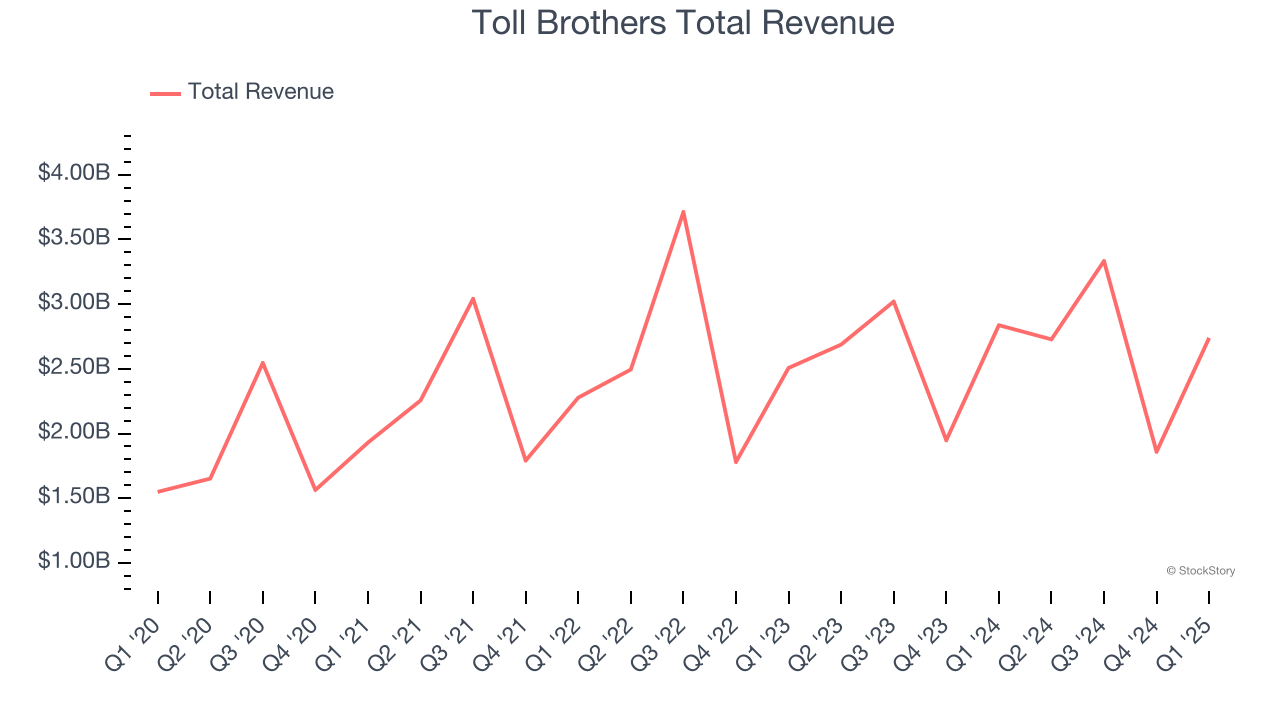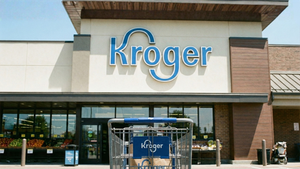
The end of an earnings season can be a great time to discover new stocks and assess how companies are handling the current business environment. Let’s take a look at how Toll Brothers (NYSE: TOL) and the rest of the home builders stocks fared in Q1.
Traditionally, homebuilders have built competitive advantages with economies of scale that lead to advantaged purchasing and brand recognition among consumers. Aesthetic trends have always been important in the space, but more recently, energy efficiency and conservation are driving innovation. However, these companies are still at the whim of the macro, specifically interest rates that heavily impact new and existing home sales. In fact, homebuilders are one of the most cyclical subsectors within industrials.
The 12 home builders stocks we track reported a slower Q1. As a group, revenues beat analysts’ consensus estimates by 1.4%.
Thankfully, share prices of the companies have been resilient as they are up 7.1% on average since the latest earnings results.
Best Q1: Toll Brothers (NYSE: TOL)
Started by two brothers who started by building and selling just one home in Pennsylvania, today Toll Brothers (NYSE: TOL) is a luxury homebuilder across the United States.
Toll Brothers reported revenues of $2.74 billion, down 3.5% year on year. This print exceeded analysts’ expectations by 9.9%. Overall, it was an incredible quarter for the company with an impressive beat of analysts’ EBITDA estimates and a solid beat of analysts’ EPS estimates.
Douglas C. Yearley, Jr., chairman and chief executive officer, stated: “We are pleased with our second quarter results, as we delivered earnings that significantly exceeded expectations. Despite a softer demand environment, we generated record second quarter home sales revenues of $2.71 billion, well above our guidance of $2.47 billion, and beat both our adjusted gross margin and SG&A guidance. We believe these results highlight the strength of our broadly diversified luxury product offerings, price points and geographies, our balanced portfolio of build-to-order and spec homes, and our strategy of prioritizing sales price and margin over pace in the current environment. Based on our first half results and the strength of our backlog, we are reaffirming our full year guidance.

Toll Brothers pulled off the biggest analyst estimates beat of the whole group. Unsurprisingly, the stock is up 14.8% since reporting and currently trades at $119.90.
Is now the time to buy Toll Brothers? Access our full analysis of the earnings results here, it’s free.
Taylor Morrison Home (NYSE: TMHC)
Named “America’s Most Trusted Home Builder” in 2019, Taylor Morrison Home (NYSE: TMHC) builds single family homes and communities across the United States.
Taylor Morrison Home reported revenues of $1.90 billion, up 11.5% year on year, outperforming analysts’ expectations by 5.7%. The business had a strong quarter with an impressive beat of analysts’ EBITDA estimates.

Taylor Morrison Home delivered the fastest revenue growth among its peers. The market seems happy with the results as the stock is up 9.3% since reporting. It currently trades at $64.25.
Is now the time to buy Taylor Morrison Home? Access our full analysis of the earnings results here, it’s free.
Weakest Q1: LGI Homes (NASDAQ: LGIH)
Based in Texas, LGI Homes (NASDAQ: LGIH) is a homebuilding company specializing in constructing affordable, entry-level single-family homes in desirable communities across the United States.
LGI Homes reported revenues of $351.4 million, down 10.1% year on year, falling short of analysts’ expectations by 5%. It was a disappointing quarter as it posted a significant miss of analysts’ adjusted operating income estimates.
LGI Homes delivered the weakest performance against analyst estimates in the group. As expected, the stock is down 5.4% since the results and currently trades at $56.
Read our full analysis of LGI Homes’s results here.
KB Home (NYSE: KBH)
The first homebuilder to be listed on the NYSE, KB Home (NYSE: KB) is a homebuilding company targeting the first-time home buyer and move-up buyer markets.
KB Home reported revenues of $1.53 billion, down 10.5% year on year. This result topped analysts’ expectations by 1.6%. Aside from that, it was a slower quarter as it logged a significant miss of analysts’ EBITDA and backlog estimates.
The stock is up 4.7% since reporting and currently trades at $55.88.
Read our full, actionable report on KB Home here, it’s free.
Meritage Homes (NYSE: MTH)
Originally founded in 1985 in Arizona as Monterey Homes, Meritage Homes (NYSE: MTH) is a homebuilder specializing in designing and constructing energy-efficient and single-family homes in the US.
Meritage Homes reported revenues of $1.36 billion, down 7.5% year on year. This number beat analysts’ expectations by 2.4%. Aside from that, it was a mixed quarter as it also logged full-year revenue guidance beating analysts’ expectations but a significant miss of analysts’ backlog estimates.
Meritage Homes delivered the highest full-year guidance raise among its peers. The stock is up 4.1% since reporting and currently trades at $70.97.
Read our full, actionable report on Meritage Homes here, it’s free.
Market Update
Thanks to the Fed’s series of rate hikes in 2022 and 2023, inflation has cooled significantly from its post-pandemic highs, drawing closer to the 2% goal. This disinflation has occurred without severely impacting economic growth, suggesting the success of a soft landing. The stock market thrived in 2024, spurred by recent rate cuts (0.5% in September and 0.25% in November), and a notable surge followed Donald Trump’s presidential election win in November, propelling indices to historic highs. Nonetheless, the outlook for 2025 remains clouded by potential trade policy changes and corporate tax discussions, which could impact business confidence and growth. The path forward holds both optimism and caution as new policies take shape.
Want to invest in winners with rock-solid fundamentals? Check out our Strong Momentum Stocks and add them to your watchlist. These companies are poised for growth regardless of the political or macroeconomic climate.




